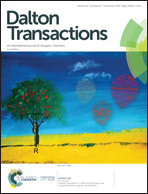Mechanistic insights of anionic ligand exchange and fullerene reduction with magnesium(i) compounds†
Abstract
Ligand exchange reactions between combinations of the complexes [{(Arnacnac)Mg}2], where Ar = 2,6-iPr2C6H3 (Dip), 2,6-Et2C6H3 (Dep), 2,4,6-Me4C6H2 (Mes), and 2,6-Me2C6H3 (Xyl), [({Ph2P(NDip)2}Mg)2], [(Arnacnac)Li], where Ar = Mes or Xyl, and [{Ph2P(NDip)2}Li] were studied in deuterated aromatic and aliphatic solvents, and tetrahydrofuran. The reactions afforded product mixtures with asymmetrically substituted dimagnesium(I) complexes [(Arnacnac)MgMg(Ar′nacnac)], where Ar, Ar′ = Dip, Dep, Mes, Xyl and [{Ph2P(NDip)2}MgMg(Arnacnac)], where Ar = Mes or Xyl, and suggest that the exchange of anionic ligands on the Mg22+ ion proceeds via an associative mechanism and is strongly dependent on ligand sterics and ligand shape, and can be very rapid. The activation reaction of fullerene C60 by dimagnesium(I) complexes [{(Arnacnac)Mg}2] and [({Ph2P(NDip)2}Mg)2] to fulleride complexes is similarly dependent on ligand sterics and ligand shape, but likely does not involve direct coordination of the fullerene to the Mg centre in dimagnesium(I) compounds prior to its reduction. The new C606− fulleride complex [({Ph2P(NDip)2}Mg)6C60] was prepared, and spectroscopically and structurally characterised.



 Please wait while we load your content...
Please wait while we load your content...